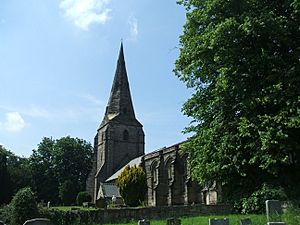Bebington facts for kids
Quick facts for kids Bebington |
|
|---|---|
 St Andrew's Church, Lower Bebington |
|
| Population | 15,768 (2011 census) |
| OS grid reference | SJ333841 |
| • London | 176 mi (283 km) SE |
| Metropolitan borough | |
| Metropolitan county | |
| Region | |
| Country | England |
| Sovereign state | United Kingdom |
| Post town | WIRRAL |
| Postcode district | CH63 |
| Dialling code | 0151 |
| ISO 3166 code | GB-WRL |
| Police | Merseyside |
| Fire | Merseyside |
| Ambulance | North West |
| EU Parliament | North West England |
| UK Parliament |
|
Bebington is a town located in Merseyside, England. It's part of the Metropolitan Borough of Wirral. Historically, it was part of Cheshire.
Bebington is about 5 miles (8 km) south of Liverpool. It is close to the River Mersey on the eastern side of the Wirral Peninsula. Nearby towns include Birkenhead and Wallasey. Bebington railway station opened in 1838. It is part of the Merseyrail network.
In 2011, the Bebington area had a population of 15,768 people. Some parts of Bebington include Port Sunlight, New Ferry, and Spital. A study in 2015 found that Bebington's postcode area, CH63, was a great place to live and work. It had a good balance of homes, jobs, and schools.
Contents
Bebington's Rich History
The name Bebington comes from an old Anglo-Saxon word. It means "Village of Bebba," likely named after a Saxon leader.
The Battle of Brunanburh
Bebington is thought to be the site of a very important battle. This was the Battle of Brunanburh in 937 AD. It was a huge victory for the English army. King Æthelstan and his brother Edmund led the English. They defeated a combined army of Vikings and Scots.
This battle was one of the biggest in Anglo-Saxon history. It helped shape England as a country. Today, the Brackenwood golf course is believed to be the most likely spot for this battle. The story of the battle is told in an old English poem.
Early Bebington Life
The Church of St. Andrew has been on its site since Saxon times. The current church buildings are from the 14th and 16th centuries.
In 1801, Bebington was a small village with only 273 people. It was on a main road connecting Chester and Birkenhead. Many horse-drawn coaches passed through each day. Later, a railway opened in 1840, and a new road in 1844. This meant Bebington lost its busy coaching traffic.
Dinosaur Footprints and Famous Stone
In 1838, some amazing archosaur footprints were found. They were in a sandstone quarry at Storeton. These footprints belong to a creature called the Chirotherium storetonese. You can see examples of these footprints in the Liverpool Museum.
Stone from Bebington quarries was used for important buildings. It helped build Birkenhead Town Hall. Most famously, this creamy sandstone was used for the Empire State Building in New York City! The quarries were later filled in with dirt from the Mersey Tunnels.
Joseph Mayer and Mayer Hall
Mayer Hall in Lower Bebington was once an art gallery. It was built by Joseph Mayer. He was a famous collector of old items, especially Anglo-Saxon ones. His collection helped develop British archaeology. Today, Mayer Hall is still used by the community.
Where is Bebington?
Bebington is on the eastern side of the Wirral Peninsula. It is about 10 km (6 mi) south-south-east of the Irish Sea. It's also less than 2 km (1 mi) west-north-west of the River Mersey. The area is generally between 20 and 60 meters (66-197 ft) above sea level.
 |
Prenton | Rock Ferry | New Ferry |  |
| Storeton | Port Sunlight | |||
| Brimstage | Clatterbridge Raby Mere |
Spital Bromborough |
Schools in Bebington
Bebington has many schools for young people. These include:
- Wirral Grammar School for Boys
- Wirral Grammar School for Girls
- St John Plessington Catholic College
- St John's Junior and Infant Schools
- Higher Bebington Junior School
- Co-op Academy Bebington
- Brackenwood Junior School
- Stanton Road Primary School
- St Andrew's Primary School
- Town Lane Infants School
- Church Drive Primary School
Bebington During World War II
In March 1942, Bebington took part in a 'Warship Week' campaign. This was a national effort to raise money for the war. After a successful campaign, the town adopted a warship, HMS Sabre (H18). This meant Bebington helped support the ship during World War II.
Famous People from Bebington
Many interesting people have connections to Bebington:
- Liz Carr (born 1972), an actress and activist for disability rights.
- Frances Jacson (1754–1842), a novelist.
- Lottie Dod (1871–1960), a famous athlete and five-time Wimbledon tennis champion.
- Dixie Dean (1907–1980), a professional footballer, lived in Higher Bebington.
- Michael Goodliffe (1914–1976), a film and television actor.
- Hilda R. Ellis Davidson (1914–2006), a historian.
- Harold Wilson (1916–1995), who became a British Prime Minister, lived here and was head boy at Wirral Grammar School.
- Roger Lancelyn Green (1918–1987) and Richard Lancelyn Green (1953–2004), both authors.
- Kenneth Halliwell (1926–1967), known for his connection to playwright Joe Orton.
- Brian Harris (1935–2008), a professional footballer.
- Phil Liggett (born 1943), a cycling commentator.
- Alex Cox (born 1954), a film director.
- Ted Robbins (born 1955), an entertainer and actor.
- Jan Ravens (born 1958), an impressionist and actress.
- Pete Burns (1959–2016), a singer.
- Chris Sharrock (born 1964), a drummer for bands like Oasis.
- Chris Malkin (born 1967), a former professional footballer.
- Paul Nowak (born 1972), a trade unionist.
- Matt Cairns (born 1979), a professional rugby player.
- Dom Phillips (died 2022), a journalist.
- Jean Boht (1932–2023), an English actress, famous for her role in the TV show Bread.
See also
 In Spanish: Bebington para niños
In Spanish: Bebington para niños


